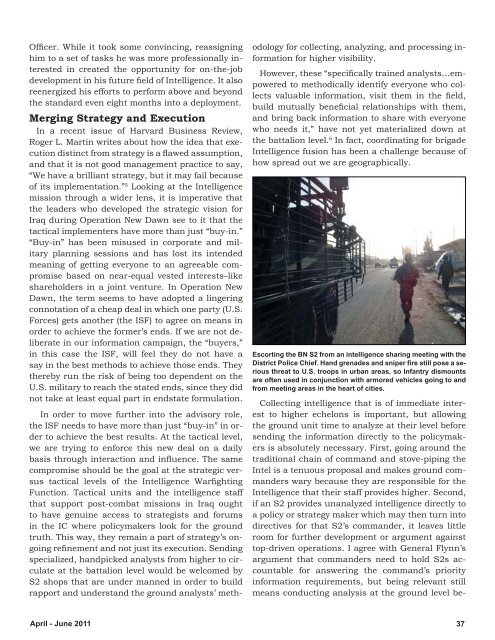George w. casey jr. - Federation of American Scientists
George w. casey jr. - Federation of American Scientists
George w. casey jr. - Federation of American Scientists
Create successful ePaper yourself
Turn your PDF publications into a flip-book with our unique Google optimized e-Paper software.
Officer. While it took some convincing, reassigning<br />
him to a set <strong>of</strong> tasks he was more pr<strong>of</strong>essionally interested<br />
in created the opportunity for on-the-job<br />
development in his future field <strong>of</strong> Intelligence. It also<br />
reenergized his efforts to perform above and beyond<br />
the standard even eight months into a deployment.<br />
Merging Strategy and Execution<br />
In a recent issue <strong>of</strong> Harvard Business Review,<br />
Roger L. Martin writes about how the idea that execution<br />
distinct from strategy is a flawed assumption,<br />
and that it is not good management practice to say,<br />
“We have a brilliant strategy, but it may fail because<br />
<strong>of</strong> its implementation.” 5 Looking at the Intelligence<br />
mission through a wider lens, it is imperative that<br />
the leaders who developed the strategic vision for<br />
Iraq during Operation New Dawn see to it that the<br />
tactical implementers have more than just “buy-in.”<br />
“Buy-in” has been misused in corporate and military<br />
planning sessions and has lost its intended<br />
meaning <strong>of</strong> getting everyone to an agreeable compromise<br />
based on near-equal vested interests–like<br />
shareholders in a joint venture. In Operation New<br />
Dawn, the term seems to have adopted a lingering<br />
connotation <strong>of</strong> a cheap deal in which one party (U.S.<br />
Forces) gets another (the ISF) to agree on means in<br />
order to achieve the former’s ends. If we are not deliberate<br />
in our information campaign, the “buyers,”<br />
in this case the ISF, will feel they do not have a<br />
say in the best methods to achieve those ends. They<br />
thereby run the risk <strong>of</strong> being too dependent on the<br />
U.S. military to reach the stated ends, since they did<br />
not take at least equal part in endstate formulation.<br />
In order to move further into the advisory role,<br />
the ISF needs to have more than just “buy-in” in order<br />
to achieve the best results. At the tactical level,<br />
we are trying to enforce this new deal on a daily<br />
basis through interaction and influence. The same<br />
compromise should be the goal at the strategic versus<br />
tactical levels <strong>of</strong> the Intelligence Warfighting<br />
Function. Tactical units and the intelligence staff<br />
that support post-combat missions in Iraq ought<br />
to have genuine access to strategists and forums<br />
in the IC where policymakers look for the ground<br />
truth. This way, they remain a part <strong>of</strong> strategy’s ongoing<br />
refinement and not just its execution. Sending<br />
specialized, handpicked analysts from higher to circulate<br />
at the battalion level would be welcomed by<br />
S2 shops that are under manned in order to build<br />
rapport and understand the ground analysts’ methodology<br />
for collecting, analyzing, and processing information<br />
for higher visibility.<br />
However, these “specifically trained analysts…empowered<br />
to methodically identify everyone who collects<br />
valuable information, visit them in the field,<br />
build mutually beneficial relationships with them,<br />
and bring back information to share with everyone<br />
who needs it,” have not yet materialized down at<br />
the battalion level. 6 In fact, coordinating for brigade<br />
Intelligence fusion has been a challenge because <strong>of</strong><br />
how spread out we are geographically.<br />
Escorting the BN S2 from an intelligence sharing meeting with the<br />
District Police Chief. Hand grenades and sniper fire still pose a serious<br />
threat to U.S. troops in urban areas, so Infantry dismounts<br />
are <strong>of</strong>ten used in conjunction with armored vehicles going to and<br />
from meeting areas in the heart <strong>of</strong> cities.<br />
Collecting intelligence that is <strong>of</strong> immediate interest<br />
to higher echelons is important, but allowing<br />
the ground unit time to analyze at their level before<br />
sending the information directly to the policymakers<br />
is absolutely necessary. First, going around the<br />
traditional chain <strong>of</strong> command and stove-piping the<br />
Intel is a tenuous proposal and makes ground commanders<br />
wary because they are responsible for the<br />
Intelligence that their staff provides higher. Second,<br />
if an S2 provides unanalyzed intelligence directly to<br />
a policy or strategy maker which may then turn into<br />
directives for that S2’s commander, it leaves little<br />
room for further development or argument against<br />
top-driven operations. I agree with General Flynn’s<br />
argument that commanders need to hold S2s accountable<br />
for answering the command’s priority<br />
information requirements, but being relevant still<br />
means conducting analysis at the ground level be-<br />
April - June 2011 37















